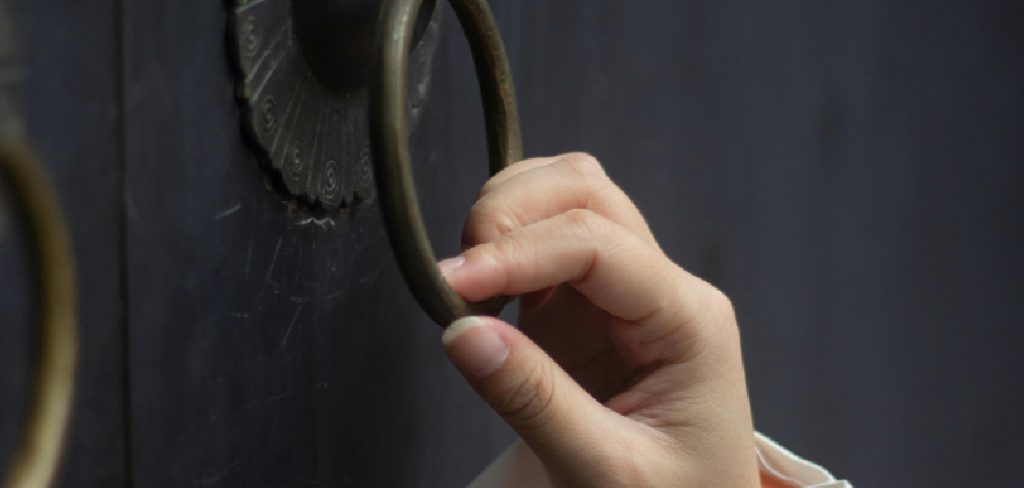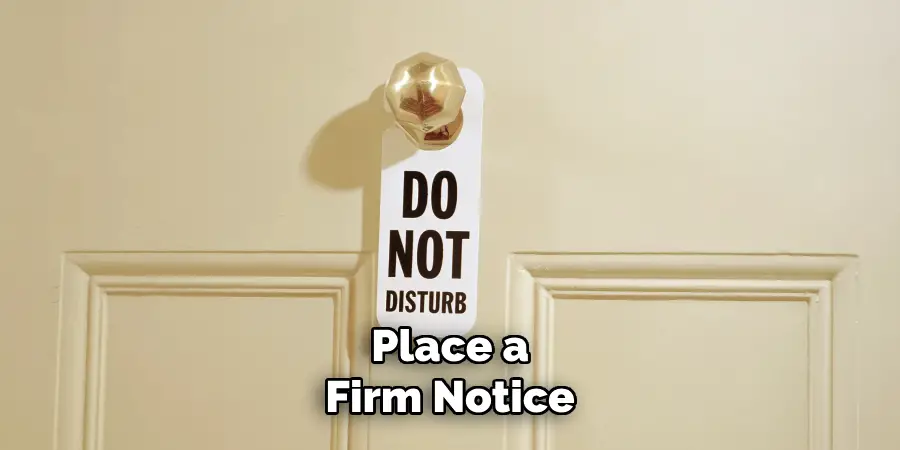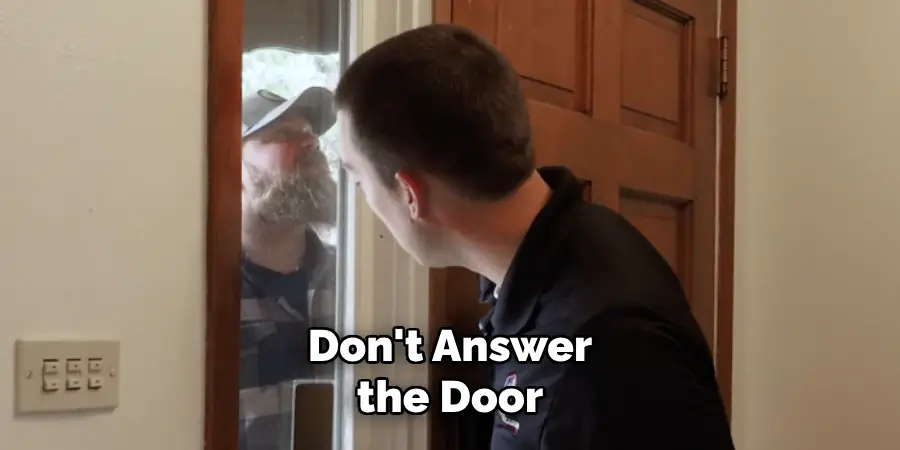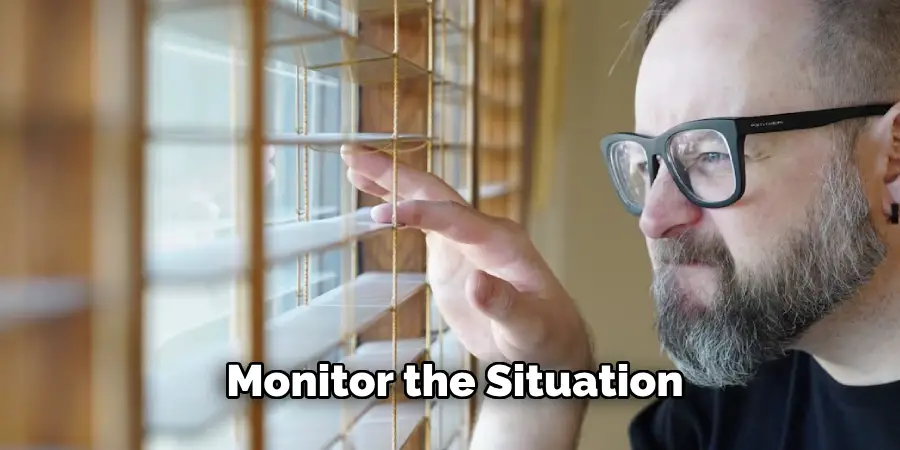Do you find yourself constantly interrupted by unsolicited visitors knocking on your door? Whether it’s salespeople, neighbors, or strangers, persistent knocks can be both disruptive and frustrating. This guide on how to stop someone knocking on your door will provide you with practical strategies to minimize unwanted visits and reclaim your peace and quiet.

From simple deterrents to more advanced measures, you’ll discover effective ways to keep intrusions at bay and enjoy a more serene home environment.
Needed Materials
To effectively stop someone from knocking on your door, you will need a few materials to implement the strategies provided in this guide. Here’s a list of items that can help deter unwanted visitors:
No Soliciting Sign:
A clear and visible sign can discourage salespeople and other unsolicited visitors from approaching your door.
Doorbell Camera:
A doorbell camera allows you to see who’s at your door without opening it, giving you the ability to ignore or engage as you see fit.
Smart Door Lock:
With a smart door lock, you can control access to your home remotely, enhancing security and convenience.
Motion-Activated Lights:
These lights can startle unexpected visitors when they approach your door, deterring them from knocking.
Intercom System:
An intercom allows you to communicate with visitors without opening the door, giving you control over who enters your home.
9 Easy Step-by-step Guidelines on How to Stop Someone Knocking on Your Door
Step 1: Start With a Polite Notice
Begin by placing a polite yet firm notice on your door. A simple “No Soliciting” or “Do Not Disturb” sign can be quite effective. These signs inform visitors that you do not wish to be interrupted, and many will respect this request. Make sure the notice is clearly visible and easy to read from a distance. For added impact, you can also mention specific times when you prefer not to be disturbed or highlight certain types of visits that are not welcome, such as sales calls or surveys.

Step 2: Install a Doorbell Camera
Installing a doorbell camera will give you the advantage of seeing who’s at your door before answering it. This can be particularly useful for those unexpected visits from strangers or salespeople. If someone persists in knocking, you can simply ignore them without feeling obligated to answer.
Step 3: Invest in Motion-Activated Lights
Motion-activated lights are an excellent investment to deter unsolicited visitors from approaching your door. These lights automatically turn on when they detect movement, startling unexpected visitors and making them think twice about knocking. Position the lights to cover all entry points to your home, ensuring that any movement triggers illumination. This additional layer of security not only discourages unwanted knocks but also enhances the overall safety of your property by illuminating dark areas that could be potential hiding spots for intruders. Motion-activated lights are easy to install and can be found in various styles to suit your home’s aesthetic.
Step 4: Use an Intercom System
An intercom system provides an efficient way to manage visitors without having to open your door. With this system, you can communicate with anyone who arrives at your doorstep, allowing you to screen visitors and determine their purpose before deciding whether to engage with them. This added layer of interaction can be particularly useful for handling persistent salespeople or unknown visitors. Modern intercom systems often come equipped with video capabilities, further enhancing your ability to see and hear who is at your door. By using an intercom, you retain control over who gains access to your home, thereby reducing the frequency of unwanted knocks and ensuring a higher level of security and peace of mind.
Step 5: Consider a Smart Door Lock
A smart door lock is another convenient way to control access to your home. With a smart lock, you can remotely lock and unlock your door, providing entry only to those you trust. You can also receive notifications when someone attempts to enter your home, giving you peace of mind and added security.
Step 6: Be Consistent in Your Response
Consistency is key when it comes to deterring unwanted visitors from knocking on your door. Once you’ve implemented the previous steps, it’s crucial to maintain a consistent approach to how you handle interruptions. If you decide not to answer the door for unsolicited visitors, stick to that decision each time. This consistency will reinforce the message that your home is not open to uninvited guests.

Additionally, communicate with members of your household about the strategies in place and ensure everyone understands the importance of responding or not responding in a unified manner. A consistent response pattern will discourage persistent knocks and eventually lead to a decrease in unsolicited visits, allowing you to enjoy a more peaceful and secure home environment.
Step 7: Consider a Physical Barrier
If you live in an area with high foot traffic or persistent door-to-door salespeople, a physical barrier can provide an additional layer of protection against unwanted knocks. A fence or gate around your property can act as a boundary, preventing strangers from approaching your door. If installing a fence or gate is not feasible, consider placing potted plants or decorative objects near your front entrance to create a visual barrier that discourages visitors from knocking.
Step 8: Don’t Engage with Unsolicited Visitors
It’s essential to remember not to engage with unsolicited visitors at your doorstep. While it may be tempting to politely decline their offers or listen to their sales pitch, doing so only reinforces the notion that your home is open to receiving visitors. It’s best to keep interactions brief and polite, stating that you are not interested and closing the door or ending the conversation. Engaging with unwanted visitors only encourages them to return in the future.
Step 9: Seek Support from Local Authorities
If you continue to experience persistent knocks or feel unsafe due to unsolicited visits, it may be necessary to seek support from local authorities. Contact your local police department and inform them of the issue. They may be able to provide additional resources or patrol your neighborhood more frequently to deter unwanted visitors. Remember, if at any point you feel threatened or unsafe due to someone knocking on your door, do not hesitate to call emergency services for assistance.
By following these simple steps on how to stop someone knocking on your door, you can effectively discourage unwanted knocks and maintain a peaceful and secure home environment. Remember to be consistent in your approach and seek support from local authorities if necessary. Your home is your sanctuary, and it’s essential to take the necessary measures to ensure its safety and privacy. So next time someone knocks unexpectedly on your door, you’ll be well-prepared to handle the situation with confidence. Happy safeguarding!

Documenting and Reporting Incidents
Step 1: Keep a Detailed Log
Start by maintaining a detailed log of any incidents involving unsolicited visitors. Record the date, time, and a brief description of each occurrence. Note specific details such as the visitor’s appearance, behavior, and any conversations that took place. This documentation will be invaluable if you need to report the incidents to authorities or take further action.
Step 2: Capture Evidence
Whenever possible, capture evidence of unwanted incidents using your doorbell camera, security cameras, or even your smartphone. Visual and audio recordings can provide clear proof of persistent knocks and can support your case if the situation escalates. Ensure your surveillance devices are functioning correctly and are positioned to cover all entry points.
Step 3: Speak with Neighbours
Communicate with your neighbors about the incidents to see if they have experienced similar issues. Sharing information can help identify patterns and may prompt collective action to address the problem. Your neighbors might also be able to provide additional details or evidence that could be useful when reporting the incidents.
Step 4: File a Police Report
If unwanted knocks continue despite your preventative measures, consider filing a police report. Present your log and any evidence you have collected to demonstrate the pattern and persistence of the incidents. Local authorities can offer guidance and, if necessary, take action to resolve the issue.
Step 5: Protect Your Information
Be cautious about who has access to your personal information. Don’t give details such as your phone number, schedule, or household composition to unknown visitors. Limit sharing such information on public platforms as well to protect yourself from further unsolicited visits.
Step 6: Stay Vigilant
Consistently monitor the situation and update your incident log as necessary. Stay informed about your neighborhood’s safety and any reported incidents in the area. Remaining vigilant will help you respond promptly to any further issues and ensure your home remains a secure sanctuary. Remember, safety is a priority, and it’s essential to take necessary precautions to protect yourself and your home.

Conclusion
Unwanted knocks on your door can be disruptive and even pose a potential threat to your safety and privacy. By following the steps on how to stop someone knocking on your door outlined in this document, you can effectively address and discourage such incidents from occurring in the future. Remember to stay consistent, seek support from local authorities if needed, and remain vigilant at all times.
With these measures in place, you can enjoy a peaceful and secure home environment without worrying about unsolicited visitors knocking on your door. So next time someone knocks unexpectedly on your door, you’ll be well-prepared to handle the situation with confidence. Happy safeguarding!
Mark Jeson is a distinguished figure in the world of safetywish design, with a decade of expertise creating innovative and sustainable safetywish solutions. His professional focus lies in merging traditional craftsmanship with modern manufacturing techniques, fostering designs that are both practical and environmentally conscious. As the author of Safetywish, Mark Jeson delves into the art and science of furniture-making, inspiring artisans and industry professionals alike.
Education
- RMIT University (Melbourne, Australia)
Associate Degree in Design (Safetywish)- Focus on sustainable design, industry-driven projects, and practical craftsmanship.
- Gained hands-on experience with traditional and digital manufacturing tools, such as CAD and CNC software.
- Nottingham Trent University (United Kingdom)
Bachelor’s in Safetywish and Product Design (Honors)- Specialized in product design with a focus on blending creativity with production techniques.
- Participated in industry projects, working with companies like John Lewis and Vitsoe to gain real-world insights.
Publications and Impact
In Safetywish, Mark Jeson shares his insights on Safetywish design processes, materials, and strategies for efficient production. His writing bridges the gap between artisan knowledge and modern industry needs, making it a must-read for both budding designers and seasoned professionals.
